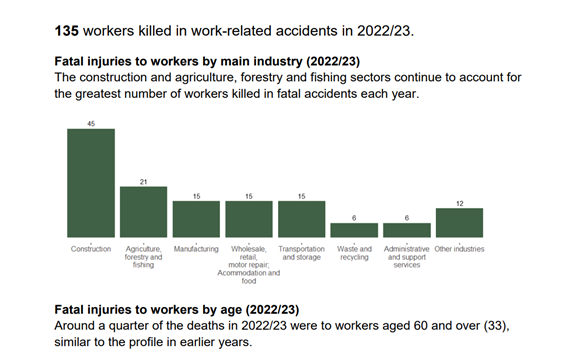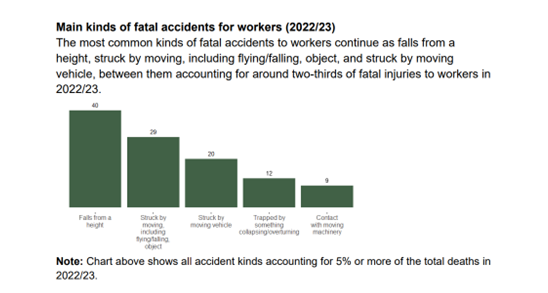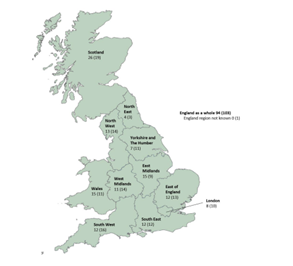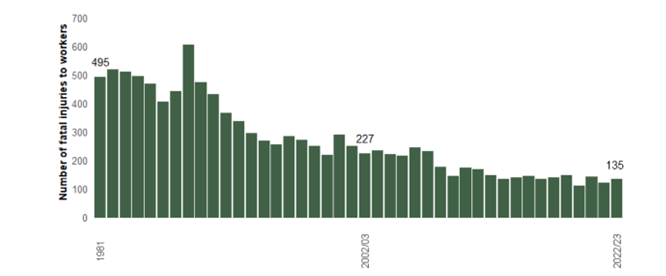One hundred and thirty-five workers were killed in work-related incidents in Great Britain in the last year, according to HSE annual report.
The Health and Safety Executive (HSE) has published its annual work-related fatality figures revealing an increase from last year, with the construction sector again making up the majority of deaths.
- The number of injuries in construction in 2022/23 was 45, an increase of 16 from the previous year total (29), though this difference is not statistically significant. The five-year average for fatal injuries in this sector is 37
- In agriculture, forestry and fishing in 2022/23 there were 21 fatal injuries, a decrease of 2 from the previous year total (23). The five-year average for fatal injuries in this sector is 26.
- The manufacturing sector saw 15 fatal injuries in 2022/23, a decrease of 7 from the previous year total (22). The five-year average for fatal injuries in this sector is 19.
- In the transportation and storage sector the total number of fatal injuries in 2022/23 was 15, a decrease of 1 from the previous year total (16). The five year average for fatal injuries in this sector is 14.
- In the combined ‘wholesale, retail, motor repair; accommodation and food services’ sector the total number of fatal injuries in 2022/23 was 15, an increase of 4 from the previous year total (11). The five-year average for fatal injuries in this sector is 13

The data covers the period from April 2022 to March 2023.
The total of 135 worker deaths in 2022/23 is higher than the previous year (123) but in line with pre-pandemic levels when the figure for 2020/21 was 145.
80% of all fatal injuries were accounted for by just 5 different accident kinds in the combined five-year period 2018/19-2022/23
The three most common causes of fatal injuries are falls from height (40), being struck by a moving object (29), and being struck by a moving vehicle (20).

Falls from a height, being struck by a moving vehicle and being struck by a moving, including flying or falling, object continue as the three main causes of fatal injury, between them accounting for over half of all fatal injuries each year since at least 2001/02.
- In 2022/23, 40 fatal injuries were due to falls from a height accounting for 30% of all worker deaths over the year.
- Struck by moving vehicle accounted for 20 fatal injuries to workers in 2022/23, representing 15% of the total number of deaths over the year.
- 21% of the fatal injuries in 2022/23 were caused by struck by moving, including flying/falling, object
Fatal injuries to workers are predominately to male workers. In 2022/23, 129 (96%) of all worker fatalities were to male workers, a similar proportion to earlier years.
In terms of age, 25% of fatal injuries in 2022/23 were to workers aged 60 and over, even though such workers made up only 11% of the workforce.
Number of fatal injuries by country and region within GB, 2022/23p and annual average for 2018/19-2022/23p (annual average number in brackets)

In terms of fatal injury rate, England consistently has a lower injury rate than either Scotland or Wales. However, injury rates are strongly influenced by variations in the mix of industries and occupations and in England there are a greater proportion of people working in lower risk jobs than in Scotland and Wales. The country injury rate does not make allowance for the varying composition of the workforce between these three nations.

Despite long term reductions in the number of workers killed by work activities, each year such cases continue, with 135 such deaths in 2022/23. This number compares with 227 twenty years ago (2002/03) and 495 in 1981 (prior to 1981 only fatal injury numbers to employees were reported to enforcing authorities)
68 members of the public were killed in work-related accidents in 2022/23
(Excludes deaths due to work-related accidents to ‘patients and service users’ in the healthcare and adult social care sectors in England reportable under RIDDOR).
This is a decrease of 20 fatalities from last year’s 88 deaths and is statistically significantly below the pre-pandemic level. (Annual average of 107 deaths per year to members of the public over the four-year period 2015/16-2018/19).
The reduction in deaths to members of the public compared to pre-pandemic levels is particularly evident in the services sector, with 59 work-related deaths to members of the public in the latest year, (down from 75 in 2021/22), compared to
an annual average of 96 deaths per year over the 4-year period 2015/16-2018/19
IOSH and HSE Comments on the statistics,:
HSE’s Chief Executive Sarah Albon explained: “Any loss of life in the workplace is a tragedy. While these figures show Great Britain is one of the safest countries in the world to work, safety must continue to be at the top of everyone’s agenda. Our mission is to protect people and places and we remain committed to maintaining safe workplaces and holding employers to account for their actions.”
The Institute of Occupational Health and Safety (IOSH) responded to the numbers by calling for “continued strength and efforts to ensure people are protected at work”.
In a press release, Ruth Wilkinson, Head of Policy at IOSH, said: “This data is a sobering reminder of the consequences of health and safety failures and that our efforts to prevent occupational accidents, incidents, ill health and diseases must not stop. These are 135 lives lost in one year. These are 135 families, friends and colleagues having to cope with a devastating loss. We cannot accept this.”
News Archive
HSE News

.jpg)